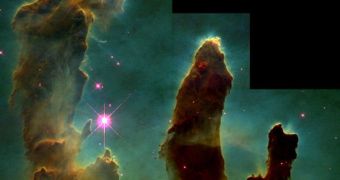The Serpens Constellation is the little-known host of the more popular Eagle Nebula, an emission zone that holds the famous Pillars of Creation, a very large and beautiful area of intense star formation, located some 7,000 light-years away. Pictures taken in 1995 by Jeff Hester and Paul Scowen, using the Hubble Space Telescope, have made the Pillars one of the most loved and recognized sites in space, but even with all the popularity, astronomers are still in doubt as to how they were formed, and what drove them to expand and to become a “stellar nursery.”
A new scientific theory, just recently released by a team of experts at the Dublin Institute for Advanced Studies, in Ireland, holds that the Pillars were created from very large clumps of gas that were pushed in darker regions of space by the radiation coming from nearby stars. Dense knots are then formed, and the shadows protect the new structures from ultraviolet radiation.
This type of electromagnetic wavelength can easily stop the formation of other amounts of gas, but, under the protection of the darker regions, the knots are “free” to create more gas again. These hypotheses have all been subtracted from a computer model that the Irish researchers have created.
“There is, as yet, no clear consensus in the literature regarding the formation of the pillars, except that it is most likely related to photo-ionization processes due to nearby massive stars. We have been able to produce [computer-generated] pillars which are roughly consistent with the sizes and lifetimes which are inferred from observations,” DIAS astrophysics researcher Andrew Lim, who has been part of the new study, said. He added for Space that thorough observations of the Pillars of Creation could, in the end, provide astronomers with more insight into how stellar nurseries around the Universe were formed.
Lim also explained that photo-ionization (or photo-evaporation) occured when the intense radiation bombardments from nearby stars reached the otherwise neutral gas and energized it. A very hot, ionized outer layer is formed around the clouds, which then explodes and expands very rapidly, sending shock waves in all directions around it. This phenomenon is believed to contribute to the formation of the stellar nurseries, which typically require lots of gas and dust to form stars, through a process known as accretion. The spawning grounds for stars span several light-years, at times, and tens of thousands of new, blue stars are concomitantly formed there.
The expert explained that there was a distinct possibility that the Pillars of Creation had been destroyed by a supernova explosion many centuries ago, but shared that light coming from the area would still show the formations as intact for at least another 1,000 years. Teams around the world will continue to study the representative stellar nurseries in the future as well, because they believe it's the best bet in understanding how the phenomenon of star formation works.

 14 DAY TRIAL //
14 DAY TRIAL //